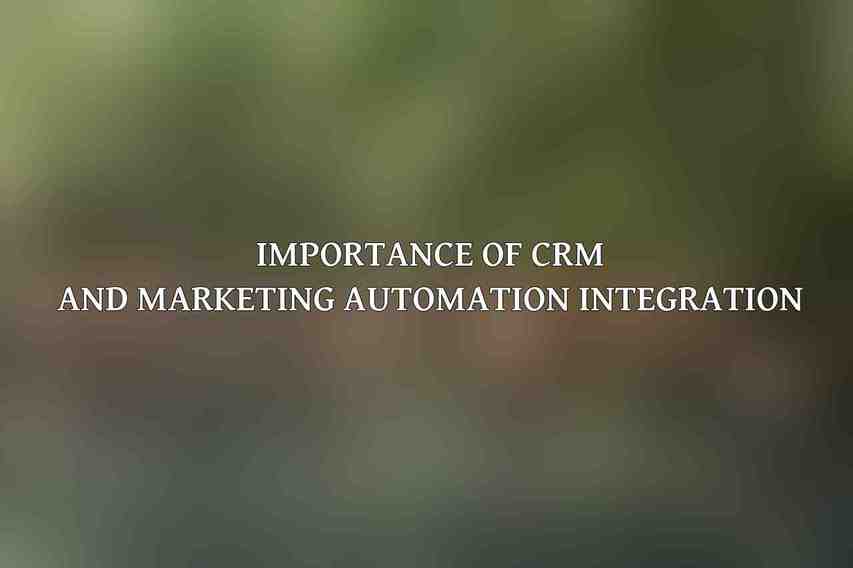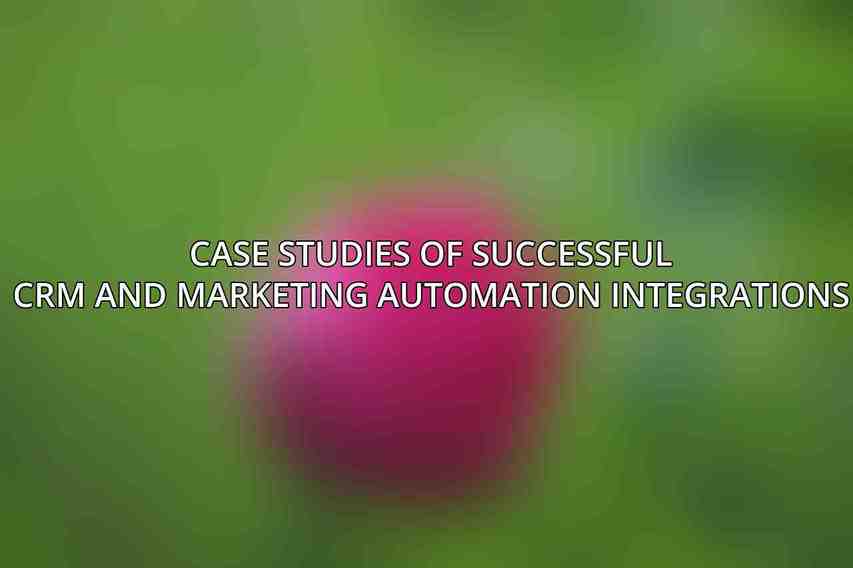Customer relationship management (crm) and marketing automation are indispensable tools for businesses aiming to streamline their operations and enhance customer engagement. crm involves managing interactions with potential and existing customers to nurture relationships and drive sales, while Marketing Automation focuses on automating marketing processes to generate leads and personalize customer experiences. When these two powerful tools are integrated, businesses can experience a seamless flow of information, enabling targeted marketing campaigns and improved customer satisfaction.
Definition of CRM and Marketing Automation
CRM encompasses technologies and strategies used by companies to manage and analyze customer interactions throughout the customer lifecycle, with the goal of improving customer relationships and driving sales. On the other hand, Marketing Automation involves using software platforms to automate marketing tasks, such as email marketing, social media posting, and customer segmentation, to increase efficiency and ROI.
Importance of CRM and Marketing Automation Integration

The integration of CRM and Marketing Automation systems allows businesses to align their sales and marketing processes, leading to a more cohesive and coordinated approach towards customer engagement. By integrating these systems, companies can ensure that customer data is centralized, up-to-date, and accessible to all relevant teams, fostering a holistic understanding of customer behavior and preferences.
Benefits of CRM and Marketing Automation Integration
- Improved Lead Management: Seamless integration enables marketers to track leads from initial contact to conversion, allowing for more targeted and effective lead nurturing.
- Enhanced Personalization: By combining CRM data with automation tools, businesses can deliver personalized content and offers based on individual customer behavior and preferences.
- Increased Efficiency: Integration streamlines workflows, eliminates redundant tasks, and automates repetitive processes, freeing up time for more strategic marketing initiatives.
Best Practices for CRM and Marketing Automation Integration
Successful integration of CRM and Marketing Automation requires careful planning and execution. Here are some best practices to follow:
Establish Clear Goals and Objectives
Before embarking on integration, define specific goals and objectives that align with your business strategy. Whether it’s to improve lead generation, increase sales conversions, or enhance customer retention, clarity on objectives will guide the integration process.
Choose Compatible CRM and Marketing Automation Tools
Select CRM and Marketing Automation platforms that are compatible and offer seamless integration capabilities. Ensure that the chosen tools can effectively communicate with each other to facilitate the exchange of data and insights.
Map CRM and Marketing Automation Data Points
Identify the key data points that need to be synchronized between CRM and Marketing Automation systems. Mapping out these data points ensures that the right information is shared across platforms for targeted marketing campaigns and personalized customer interactions.
Align Data Formats and Structures
Harmonize the formatting and structure of data between CRM and Marketing Automation systems to prevent data discrepancies or misinterpretations. Consistent data formatting facilitates accurate reporting and analysis for informed decision-making. Find more on Email Marketing and CRM Integration: How to Guide
Use Integration Tools and Platforms
Leverage integration tools and platforms, such as Zapier or PieSync, to automate the transfer of data between CRM and Marketing Automation systems. These tools simplify the integration process and reduce the likelihood of manual errors. Dive deeper into Overcoming CRM Integration Challenges: A Solution Guide
Set Up Automated Workflows and Triggers
Design automated workflows and triggers that dictate how data is shared and actions are initiated between CRM and Marketing Automation platforms. Automated processes save time, minimize manual intervention, and ensure timely responses to customer interactions.
Monitor and Optimize the Integration
Continuously monitor the integration to identify any issues or bottlenecks that may arise. Regularly assess the performance of integrated systems and make necessary adjustments to optimize efficiency and maximize results.
Step-by-Step Guide to CRM and Marketing Automation Integration
Integrating CRM and Marketing Automation systems involves a systematic approach to ensure a smooth and effective transition. Here is a step-by-step guide to follow:
Evaluate CRM and Marketing Automation Tools
Begin by evaluating your current CRM and Marketing Automation tools to assess their compatibility and integration capabilities. Consider factors such as data sharing mechanisms, customization options, and scalability to determine if they meet your integration requirements.
Establish Data Mapping and Integration
Identify the data fields in your CRM and Marketing Automation systems that need to be synchronized, such as contact information, lead status, purchase history, and engagement metrics. Create a mapping plan to ensure that data flows accurately between the two platforms.
Set Up Automated Workflows and Triggers
Define automated workflows and triggers based on predefined criteria, such as lead scoring, email opens, or website visits. These workflows automate actions like sending follow-up emails, updating contact records, or assigning leads to sales representatives, based on specific triggers.
Test and Launch the Integration
Before fully implementing the integration, conduct thorough testing to validate data accuracy, workflow functionality, and system connectivity. Address any issues or discrepancies that arise during testing to ensure a seamless launch of the integrated CRM and Marketing Automation systems.
Monitor and Analyze the Integration
Once the integration is live, monitor key performance indicators (KPIs) to track the impact of integration on marketing and sales outcomes. Analyze metrics such as lead conversion rates, customer engagement, and campaign ROI to assess the effectiveness of the integrated systems.
CRM and Marketing Automation Integration Tools
Several leading CRM and Marketing Automation tools offer robust integration capabilities to streamline marketing processes and enhance customer relationships. Some notable tools include:
| Tool | Description |
|---|---|
| Salesforce Sales Cloud | A cloud-based CRM platform that offers a comprehensive suite of sales tools and automation features. |
| HubSpot CRM | An easy-to-use CRM system that integrates seamlessly with marketing automation tools for targeted campaigns. |
| SAP Hybris Cloud for Customer Engagement | A customer engagement platform that combines CRM and marketing automation capabilities for personalized interactions. |
| Oracle Eloqua | A marketing automation platform that enables marketers to create targeted campaigns and track customer behavior. |
| Marketo | A marketing automation solution that helps businesses drive customer engagement and personalized marketing strategies. |
| Pardot | A B2B marketing automation platform by Salesforce that streamlines lead management and email marketing campaigns. |
Case Studies of Successful CRM and Marketing Automation Integrations

Real-world examples of successful CRM and Marketing Automation integrations demonstrate the transformative impact of aligning sales and marketing efforts. Here are some notable case studies:
Case Study 1: Adobe and Marketo Integration
Adobe’s acquisition of Marketo led to a seamless integration of Marketing Automation capabilities with Adobe’s CRM systems, enabling targeted marketing campaigns and personalized customer interactions at scale.
Case Study 2: Nike and Salesforce Integration
Nike leveraged Salesforce’s CRM platform to integrate customer data with Marketing Automation tools, allowing for data-driven marketing strategies and personalized experiences across all customer touchpoints.
Case Study 3: Tesla and SAP Hybris Integration
Tesla implemented SAP Hybris Cloud for Customer Engagement to unify customer data and streamline marketing processes, resulting in enhanced lead generation, improved sales conversions, and optimized customer experiences.
Common Challenges and Solutions
Despite the benefits of CRM and Marketing Automation integration, businesses may encounter challenges along the way. Here are some common challenges and solutions to consider:
Data Duplication and Inconsistency
Challenge: Data duplication and inconsistency between CRM and Marketing Automation systems can lead to inaccurate customer insights and inefficient workflows.Solution: Implement data deduplication tools and establish data governance protocols to maintain data integrity and ensure consistency across integrated systems.
Disconnected Customer Journeys
Challenge: Disjointed customer journeys due to siloed data and disconnected marketing efforts can result in a fragmented customer experience.Solution: Map out customer touchpoints and create integrated marketing strategies that span across CRM and Marketing Automation platforms to deliver a seamless and cohesive journey for customers.
Lack of Alignment Between Sales and Marketing Teams
Challenge: Misalignment between sales and marketing teams in utilizing integrated CRM and Marketing Automation systems can lead to conflicting objectives and poor collaboration.Solution: Foster open communication, establish shared goals, and provide cross-functional training to enhance alignment and collaboration between sales and marketing teams, driving unified efforts towards customer engagement.
Future Trends in CRM and Marketing Automation Integration
Looking ahead to the future, several trends are poised to shape the world of CRM and Marketing Automation integration:
Artificial Intelligence and Machine Learning
AI and Machine Learning technologies will play a pivotal role in enhancing automation, personalization, and predictive analytics within integrated CRM and Marketing Automation systems. These advancements will enable businesses to deliver hyper-personalized experiences and optimize customer engagements based on AI-driven insights. Check this blog on Leveraging CRM Integration for Better Customer Insights
Predictive Analytics and Personalization
The integration of predictive analytics tools with CRM and Marketing Automation platforms will enable businesses to forecast customer behavior, anticipate needs, and personalize marketing campaigns with greater precision. By leveraging data-driven insights, companies can tailor their messaging and offers to align with individual customer preferences.
Omnichannel Marketing and Customer Experience
The evolution towards omnichannel marketing will drive the integration of CRM and Marketing Automation systems across multiple touchpoints, including social media, mobile apps, and IoT devices. By ensuring a seamless omnichannel experience, businesses can engage customers consistently across all channels and deliver cohesive brand interactions.
the integration of CRM and Marketing Automation is a strategic imperative for modern businesses seeking to optimize customer relationships, drive marketing effectiveness, and accelerate revenue growth. By following best practices, leveraging integration tools, and learning from successful case studies, organizations can unlock the full potential of integrated systems to deliver personalized experiences and drive long-term customer loyalty. Continuous monitoring, adaptation to future trends, and a commitment to alignment between sales and marketing teams will be key to sustaining success in the dynamic world of CRM and Marketing Automation integration.
Frequently Asked Questions
What is CRM and Marketing Automation integration?
CRM and Marketing Automation integration is the process of combining customer relationship management (CRM) software with marketing automation tools to streamline processes, improve communication, and enhance customer engagement.
Why is CRM and Marketing Automation integration important?
Integrating CRM and Marketing Automation brings together sales and marketing efforts, allowing for better tracking of customer interactions, improved lead generation, and more personalized communication with customers.
What are the benefits of integrating CRM and Marketing Automation?
Some benefits of integrating CRM and Marketing Automation include increased efficiency, improved lead management, enhanced customer insights, better ROI on marketing campaigns, and streamlined communication between sales and marketing teams.
How can I effectively integrate CRM and Marketing Automation tools?
To effectively integrate CRM and Marketing Automation tools, it is important to define clear goals, align sales and marketing teams, choose compatible software platforms, establish data syncing processes, and regularly evaluate the performance of integrated systems.
What are some popular CRM and Marketing Automation tools for integration?
Popular CRM tools for integration include Salesforce, HubSpot, and Zoho CRM, while popular Marketing Automation tools include Marketo, Pardot, and HubSpot Marketing Hub. When choosing tools for integration, consider factors like scalability, ease of use, and integration capabilities.

